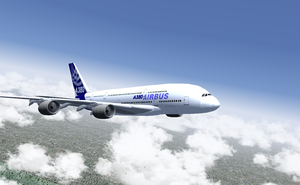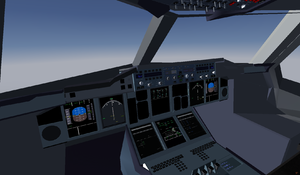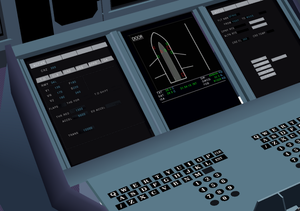Airbus A380
 | |
|---|---|
 | |
 A380 Cockpit during managed climb | |
| Type | Airliner, Cargo aircraft |
| Configuration | Low wing aircraft, Wide-body aircraft, Double-deck aircraft |
| Propulsion | Quadjet (Jet aircraft, Four-engine aircraft) |
| Manufacturer | Airbus |
| Author(s) |
|
| FDM | JSBSim |
| --aircraft= | A380 |
| Status | Production |
| FDM |
|
| Systems |
|
| Cockpit |
|
| Model |
|
| Development | |
| Website |
|
| Repository |
|
| Download |
|
| Liveries |
|
| License | GPLv2+ |
|
| |
The Airbus A380 is a double-deck, wide-body, four-engine airliner manufactured by the European corporation Airbus, an EADS subsidiary. The largest passenger airliner in the world, the A380 made its maiden flight on 27 April 2005 from Toulouse, France, and made its first commercial flight on 25 October 2007 from Singapore to Sydney with Singapore Airlines. The aircraft was known as the Airbus A3XX during much of its development phase, but the nickname Superjumbo has since become associated with it.
The A380's upper deck extends along the entire length of the fuselage. This allows for a cabin with 50% more floor space than the next-largest airliner, the Boeing 747-400, and provides seating for 525 people in standard three-class configuration or up to 853 people in all economy class configuration. The A380 is offered in passenger and freighter versions. The A380-800, the passenger model, is the largest passenger airliner in the world, superseding the Boeing 747, but has a shorter fuselage than the Airbus A340-600 which is Airbus' next biggest passenger aeroplane. The A380-800F, the freighter model, is offered as one of the largest freight aircraft, with a listed payload capacity exceeded only by the Antonov AN-225. The A380-800 has a design range of 15,700 kilometres (8,500 nm), sufficient to fly from Sydney to Helsinki, or Concepción to Dubai for example, and a cruising speed of Mach 0.85 (about 900 km/h or 560 mph at cruise altitude).
Aircraft help
An A380 Tutorial takes the reader through the detail of how to control the aircraft and use many of the Airbus specific Flight Control features. There is also in built-in tutorial to the aircraft model that helps the beginner start the aircraft.
Startup
- Set fuel and CG (CG is displayed on centre pedestal ECAM screen)
- Start APU by clicking Master SW on the overhead
- Optionally enter flight plan on MFD
- Optionally set T.O. Performance on MFD
- click on strobe and beacon lighting
- Switch Engine Start to IGN/START on overhead
- Turn on engines in pairs from the inboard first, waiting for N2 to reach 25% before starting the next pair
- once all engines are running, use the middle-mouse button to return the Engine Start knob back to Normal
- you can turn off the APU by clicking the APU Master Sw.
Takeoff
- release parking brake
- Flaps to position 2 (0-4)
- Push throttle to around 50% N1 and wait to stabilise
- use SHIFT+Page-Up to move thrust lever to FLEX or TOGA detent
- Get Vr speed (~165 kts) and rotate
- pitch up to around 10deg and maintain 210kts
- Gear up
- AP1 enabled, push HDG to managed mode if flight plan entered
- At THR LVR on PFD reduce thrust levers to CL detent using Shift+Page-Down
- Before THR ACCEL retract flaps fully
Airbus Flight Guidance
This aircraft supports the Airbus Auto-Flight System Flight Guidance controls. The controls on the AFS Control Panel operate in either "managed mode" or "selected mode". Managed mode is the normal operating position for most controls and is enabled by pushing the control. Managed Mode allows the FMC to calculate that control and will take parameters from;
- the flight plan as entered on the MFD
- the current phase of flight
- the performance characteristics as entered on the MFD
Selected Mode is enabled by pulling the control, the pilot can enter a value before enabling the control, the Flight Guidance system will attain and hold that value once the control is enabled. Use the Glareshield AFS Control Panel rather than the Autopilot Dialog (F11) as the autopilot values will be over-written by the FMC.
Flight Management System
The Flight Management Computer requires airport SID/STAR data files to be located under the FMS directory under the aircraft install path (ie: $FG_ROOT/Aircraft/A380/FMS/ ), the files are in the Level-D 767 XML Format and can be downloaded from various public websites for free or for a fee. These are used to calculate the Runway Transition, SID, SID Transition, Top of Descent, STAR Transition, STAR and Instrument Approach Path.
If you use the MFD to enter a departure and arrival airports, flight level and SID/STAR routes, the ILS frequencies will also be tuned with the current airport ILS frequency set in the active NAV1 and the destination ILS frequency set in the standby NAV1 frequency. You can then remain in "managed mode" from cruise level to ILS interception.
Development status/Issues/Todo
Volunteers with knowledge of object-orientated-programming and Nasal-scripting are needed to script the AFDX system. Those who are interested in helping should contact Ampere on the developers' mailing list or react at the talk page.
Complete
- basic model
- fuselage
- wings (with wing flex)
- vertical and horizontal stabilisers
- flaps and slats
- engines, pylons and wing-tips
- FDM
- autopilot tuning
- engine, wind, seat-belt chime sounds
- pushback
- gear retraction and doors
- fuel tanks
- cargo, crew and passenger point mass
- CL, FLEX and TOGA thrust detents and A/THR
- majority of FMS
- SID/STAR parser
- Flight Guidance Computer
- simple electrical system
- door system, just needs objects to animate!
- animated jetway positions
- auto changeover level
- Environment Control System (cabin pressurisation)
- auto-tuned VOR on NAV2
- anti-ice and air packs take bleed air
- Rembrandt lighting for;
- cockpit lighting
- cockpit panel lighting
- wing lighting
- landing lights
- tail logo lighting
- cabin lighting
Glareshield
- altitude selected mode
- heading selected mode
- speed selected mode
- vertical managed mode
- SRS
- CLB
- OP CLB
- CRZ
- DES
- OP DES
- lateral managed mode
- NAV
- LOC
- speed managed mode
- CLB
- CRZ
- DES
- localizer and approach
- Flight Director, AP 1 and AP 2
- EFIS baro select (inHg/kPa) and pressure and 'Std' setting
- ND VOR/ADF 1 and VOR/ADF 2 display switch on EFIS
- ND nearby airports display switch on EFIS
- ND traffic display switch on EFIS
- airspeed AP control on FCU selectable between knots or mach value
- altitude selectable between 100ft and 1000ft
- Pre-flight and take-off tutorial (it contains useful stuff, recommended reading)
Front Panel
- FMA on PFD (active and some armed lateral, vertical and thrust)
- indicated speed ribbon on PFD
- localizer and Glide scope indicators on PFD
- E/WD
- updated Nav Display
- ARC mode
- ROSE mode
- aerodrome moving map with 'ZOOM' scale in PLAN mode
- nearby airports on ND^
- multi-player and AI traffic on ND
- VOR/ADF left-hand and right-hand display
- E/WD checklists
- gear lever and indicators
Overhead
- apu start
- engine IGN
- strobe, beacon, nav lights, landing, nose
- seat-belt and no-smoking switches
- electrical panel
- air panel
- anti-ice panel
Pedestal
- Flaps lever
- MFD keyboard and number pad
- ECAM/SD page select
- System Display (ECAM/SD) (many pages)
- permanent data zone
- doors
- cruise
- engines
- apu
- fuel
- electrical AC
- electrical DC
- engine master switches
- MFD (several pages)
- active init
- active departure and SID
- active arrival and STAR
- T.O. Performance
- CRZ Performance
- Active Flight Plan
To Do
- window and door cut-outs (to work with door system and lighting)
- animate parking brake and
speed brake cabin interiortune LOC and G/S- flap/slat position on PFD
livery refreshlanding, wing, tail and cabin lightinglanding, wing, tail lighting switchesengine start soundscomplete PFD and EFIS selection switchescomplete ND EFIS selection switches^complete ND display modes- PLAN
LSVORMAP
- add standard procedure check-lists to EWD
- complete remaining ECAM pages (skeleton pages already in-place)
DOORAPUENGINE- COND
- WHEEL
- PRESSURE
- BLEED
ELEC ACELEC DCFUEL- HYDRAULIC
- complete remaining MFD pages (too numerous to list)
animation for air/cond overhead panelanimation for elec overhead panel- complete fuel overhead panel
- radio panels on pedestal
gear lever and indicators- thrust levers
- auto-brake selector
- standby instruments
calculation of V speeds as part of FMS- air systems;
cabin pressureand temperature complete DC and AC electrical systemreplace digit textures with text animationfix up scaling of texture sizes- ATN/FANS+
^ = in recent Git development repository
External links
- AFDX Tutorial
- ARINC 664 presentation
- Airbus A380 Family Official Homepage
- Airbus A380 Panoramic 3D Photo
- Airbus A380 Wikipedia page
| |||||
